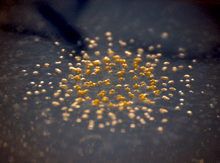Myxococcus xanthus
| Myxococcus xanthus | |
|---|---|
 | |
| Scientific classification | |
| Kingdom: | Bacteria |
| Phylum: | Proteobacteria |
| Class: | Delta Proteobacteria |
| Order: | Myxococcales |
| Family: | Myxoccaceae |
| Genus: | Myxococcus |
| Species: | M. xanthus |
| Binomial name | |
| Myxococcus xanthus Beebe 1941 | |
Myxococcus xanthus exists as a predatory saprophytic single-species biofilm called a swarm. It is a colonial gram-negative, rod-shaped bacterium. The colony, also called a "wolf-pack" is normally several inches wide, and modifies its environment via stigmergy. This behavior facilitates predatory feeding, as it increases the concentration of extracellular digestive enzymes secreted by the bacteria. During stressful conditions, the bacteria undergo a process in which about 100,000 individual cells aggregate to form a structure called the fruiting body over the course of several hours. On the interior of the fruiting body, the rod-shaped cells differentiate into spherical, thick-walled spores. They undergo changes in the synthesis of new proteins, as well as alterations in the cell wall, which parallel the morphological changes. During these aggregations, dense ridges of cells move in ripples, which wax and wane over 5 hours.
M. xanthus and evolution
In 2003, two scientists, Velicer and Yu, deleted certain parts of the M. xanthus genome, making it unable to swarm effectively on soft agar. Individuals were cloned, and allowed to evolve. After a period of 64 weeks, two of the evolving populations had started to swarm outward almost as effectively as normal wild-type colonies. However, the patterns of the swarm were very different than those of the wildtype bacteria. This suggested that they had developed a new way of moving, and Velicer and Yu confirmed this by showing that the new populations had not regained the ability to make pili, which allows wild-type bacteria to swarm. This study provided more evidence for evolution, and it addressed questions about the evolution of cooperation between individuals that had plagued scientists for years.
External links
- Model Organism Database
- Roy D. Welch Lab at Syracuse University
- Dale Kaiser Lab at Stanford University
- article on the cooperation experiment